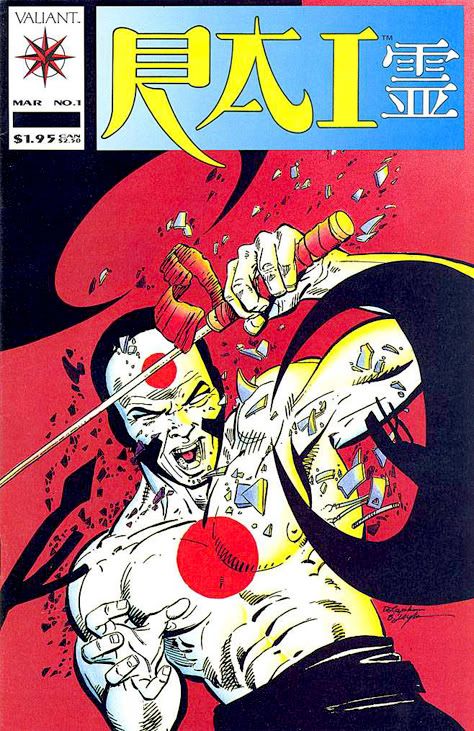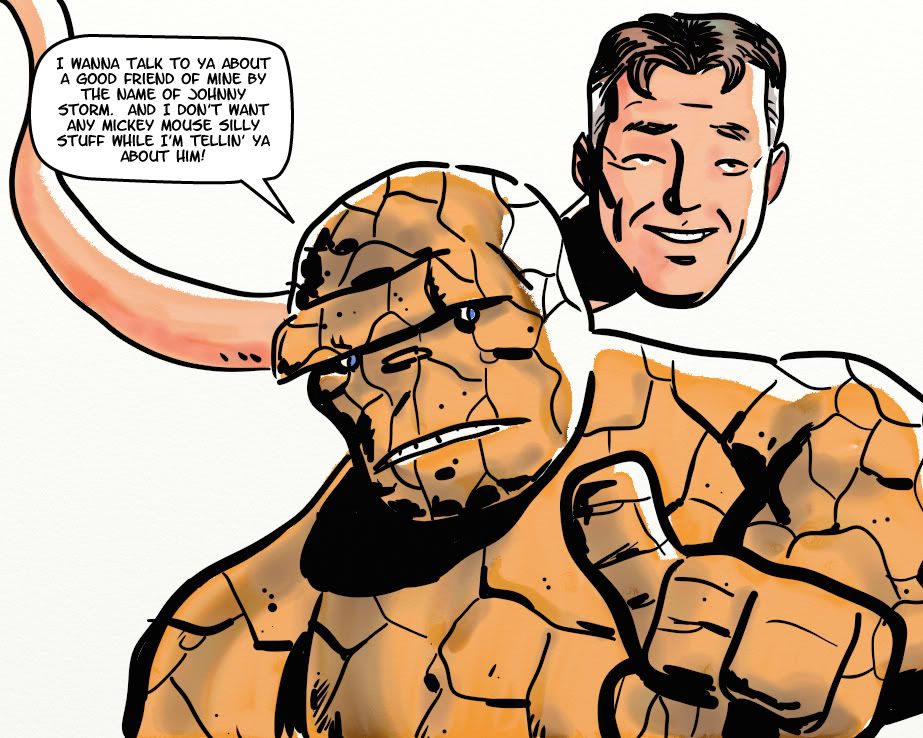
Poor Thing. That Reed Richards is a jerk.
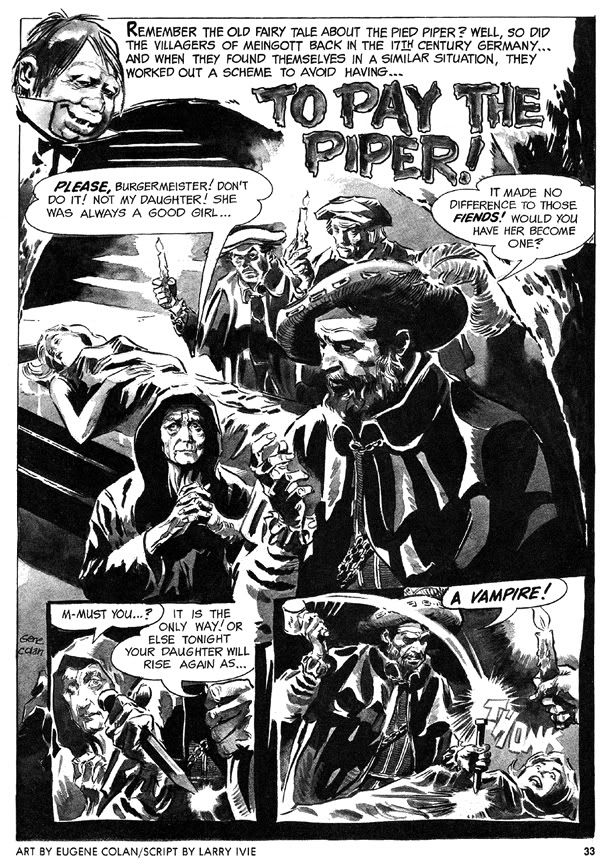 Gene Colan, one of my favorite comic artists passed away yesterday. I remember buying How to Draw Comics the Marvel Way way back when I was an artsy little kid with dreams of one day drawing comic books. The John Buscema and Jack Kirby examples inside were pretty snazzy, but what really fired my desire to draw were the little panels from what appeared to be some kind of horror comic. They were weirdly fascinating, like nothing else in the book-- dramatic low angle shots with figures that weren't quite as idealized as Kirby's and Buscema's, closer to realistic proportions despite the dynamic posing, their clothes all wrinkled and shadowed with heavy blacks. Atmospheric, even at tiny reproduction size.
Gene Colan, one of my favorite comic artists passed away yesterday. I remember buying How to Draw Comics the Marvel Way way back when I was an artsy little kid with dreams of one day drawing comic books. The John Buscema and Jack Kirby examples inside were pretty snazzy, but what really fired my desire to draw were the little panels from what appeared to be some kind of horror comic. They were weirdly fascinating, like nothing else in the book-- dramatic low angle shots with figures that weren't quite as idealized as Kirby's and Buscema's, closer to realistic proportions despite the dynamic posing, their clothes all wrinkled and shadowed with heavy blacks. Atmospheric, even at tiny reproduction size.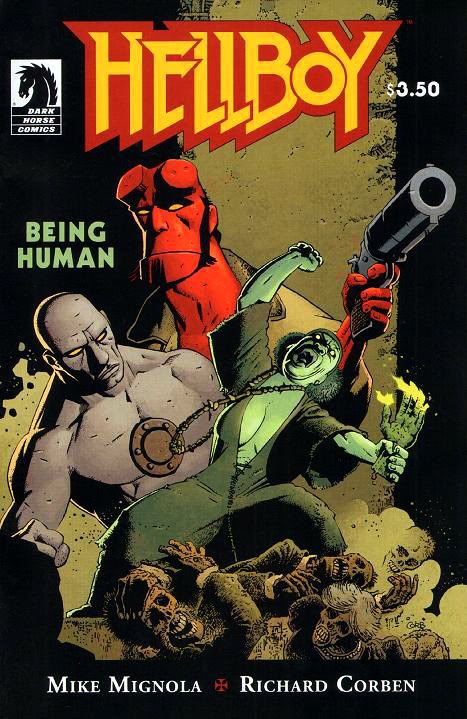 Hellboy: Being Human
Hellboy: Being HumanMike Mignola and Richard Corben team up for the sixth time* for this touching and gruesome tale in which Hellboy takes his despondent pal Roger to South Caroline so they can investigate a haunted mansion. Roger has every reason to be down—he’s a “15th century homunculus,” which apparently means he’s a big, rock-like naked guy with gray skin, an iron cap riveted into the center of his chest and some kind of block and chain chastity device covering his crotch. Roger appears to be and acts more or less a man, but he’s still figuring out what it means to be human. Hellboy, the human/demon hybrid with a blue collar attitude towards his job of punching folkloric creatures and Lovecraftian space demons, is the perfect guy to give Roger advice on the topic.
The haunting involves animated corpses, a witch and long-held family grudges. Mignola balances the weirdness with an affecting portrayal of a confused Roger, who despite his strange origins possesses an innate decency. He desperately wants to do the right thing, if only he knew what that was. As with "Makoma" and "The Crooked Man," Richard Corben proves to be an ideal match for this kind of moody, dark Hellboy story. He’s not the kind of artist who gets hung up on classical anatomy, but he gives his stumpy characters solidity and presence with his unique method of modeling, a kind of mottling or stippling. Whether it’s Roger’s stonelike skin or the mossy corpses and fungi-covered walls of the mansion, Corben is your go-to guy for sickening textures and miasmic atmospheres. Looking at these pages you can almost smell the damp plant-life and epic decay surrounding Hellboy and Roger. Corben's characters wear facial expressions that are frequently borderline comedic, but then he treats you to a stark panel where someone’s had a hole blown through her chest with gore draining out in a big red gusher. Yeah, unique. There’s not another Corben out there and we should treasure the one we have.
While I certainly don’t begrudge Mignola his forays into comedy, these uneasy tales of generational crimes and identity questions are the ones that stick with me long after I’ve closed the comic. It’s nice to revisit the tragic Roger and find Mignola amplifying those themes by exploring his character. Knowing Roger’s fate makes this story all the more poignant. "Being Human" is touching, grotesque and altogether memorable, the kind of stand-alone issue that's as rich if not richer than most multi-parters. It makes me long for the days when creators knew how to craft a story in one perfect, self-contained unit.
*Correction. Someone pointed out this isn't the third collaboration between Mignola and Corben. With the economy being the way it is and all, I've had to let go a lot of my staff. The fact checkers were the first to get pink-slipped. And while corrections are welcome and appreciated, for future reference only I am allowed to be snotty in this blog.
@sonnova Someone stole my bike. All Cassandra Cain fans will be questioned.
-Adam Beechen, Writer ("Robin," "Hench")
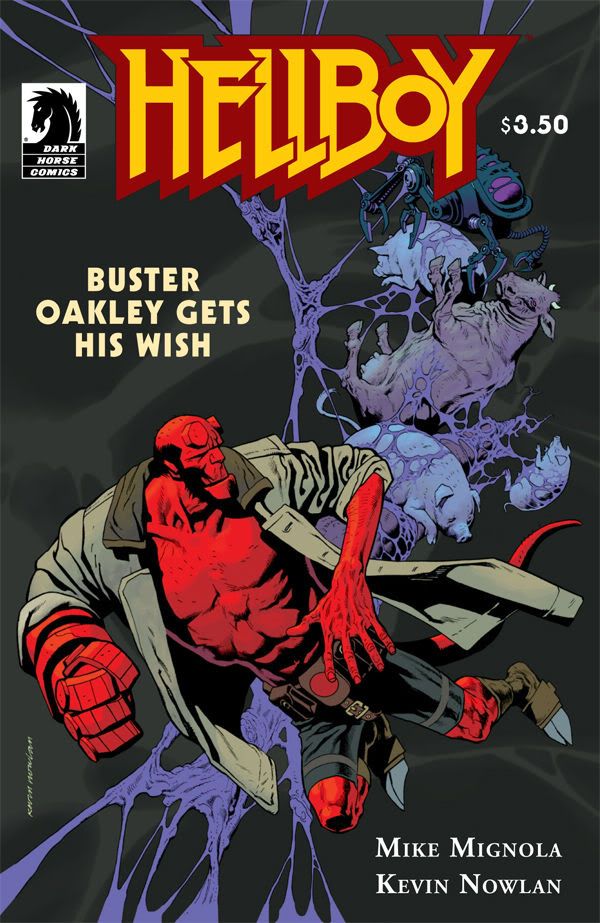 Hellboy: Buster Oakley Gets His Wish
Hellboy: Buster Oakley Gets His WishThe bulk of the plot has Hellboy fist-fighting old school macrocephalic aliens (Nowlan misses out on the chance to make them ultra-grotesque Wally Wood-type octopus creatures). The notion of aliens advanced enough to cross time and space reduced to having to duke it out with an intruder is amusing, and Hellboy's wisecracks are fun. It’s certainly nice to see him doing something other than moping about his destiny or fighting creatures from European folklore. I have to applaud Mignola for changing things up as far as Hellboy's paranormal punching bags go. I love vampires, werewolves, witches and the Fair Folk as much as anyone, but there are still Yetis, skunk apes, lake monsters, Moth Men and Mad Gassers of Mattoon out there as well. How about Hellboy going a round or two with the hodag? Alom-begwi-no-sis? Kuchisake-onna? Hanako in the toilet?
A little more substance would have elevated this team-up of powerhouse creatives. Ultimately, "Buster Oakley Gets His Wish" feels like one of those Gen13 Bootleg out of continuity one-offs; those were generally superior to the actual series, but in this case the expectations are just too high. But hey, sometimes even Hellboys just wanna have fun.
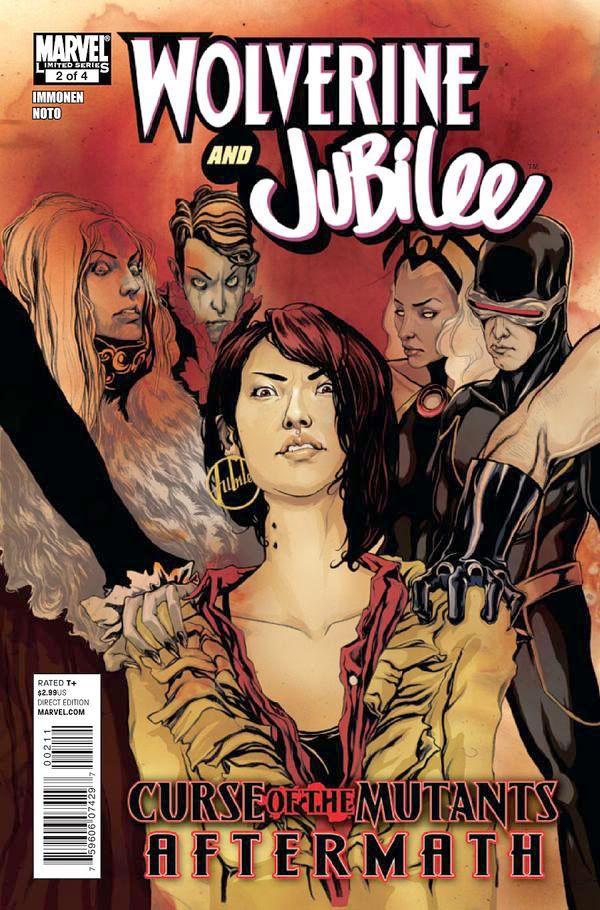 Wolverine and Jubilee 1-4
Wolverine and Jubilee 1-4I have no idea when Jubilee became the monster du jour but I believe it must have happened during one of those multi-book crossover events Marvel dumps on us every other month or so, with all the X-people fighting vampires; after all, the cover copy reads "Curse of the Mutants Aftermath." Characters refer to Jubilee's transformation and discuss how she even turned her old pal Wolverine into a vampire as well. This has understandably left the other mutants a bit wary of Jubilee, so they first keep her in a glass box as if she were Hannibal Lector’s favored daughter. After that, she moves into a nice stainless-steel business hotel room complete with a mini-fridge full of bottled Wolverine blood. I'm not sure if vampires prefer their blood chilled or at room or body temperature, but the magical red stuff flowing through Wolverine's veins is the only thing that can keep Jubilee's vampiric bloodlust in check. The X-Men and all their employees want to make sure there's plenty on hand. But what Jubilee doesn't know is they're keeping a running total and adding the charges to her bill.
Despite such apparent expertise, I have to admit my knowledge of Jubilee is kind of spotty. When I lived in Japan my workday ended at 9pm and I tried to get home in time to watch re-runs of Spider-Man and His Amazing Friends on the Disney Channel; more often than not, I came in too late and ended up watching the last few minutes of X-Men, the cult-fave cartoon from the 1990s with Jubilee as a major character. Since then, I've mostly thought of her as the spunky kid archetype, a smart-ass Kitty Pryde substitute; you know how the X-people always have to have an underage girl on the team for Wolverine to mentor. The Jubilee of my mind spends her days at the mall, wearing totally outrageous clothes ten years out of date and talking in the kind of sassy teen slang a middle-aged male comic book writer would come up with having watched a few ABC "TGIF" family sitcoms.
I bought the first issue of Wolverine and Jubilee because there wasn't much on the shelf that day and I simply hate walking out of a comic shop empty handed, especially one that seems to have about 5 customers a week. I read it a few days later, expecting little from it beyond some pretty art. To my amazement, I found myself engaged and interested in Jubilee's dilemma. For the first time in my hardboiled comic reading life, I actually cared about this character.
Writer Kathryn Immonen's achievement becomes all the more impressive because Jubilee's problems stem from the essentially silly premise of a world where superhero mutants can become vampires. Actually, in this world, the idea of mutation itself is mostly a catch-all excuse to create arbitrarily powered characters. Someone might have bird wings, another might look exactly like a frog and exhibit frog-like behaviors. And look, here comes Dracula to drink their blood. Deftly avoiding camp, Immonen crafts an affecting portrait of a young woman possessed of strange new powers, isolated and vulnerable as a result. Jubilee is uncomfortably slung between fight and flight, at war with both her elders and her contemporaries, the very people she once counted on as family.
In the opening scenes, Immonen wisely doesn't try to out-Juno Diablo Cody. Jubilee's quips are witty, but not supernaturally so. After more than half an issue of confrontations with several first- and second tier characters-- including Armor, her own replacement as resident purveyor of underage spunkiness and quips-- Jubilee becomes enchanted with a mysterious woman who also turns out to be a vampire, ever so briefly involves herself in human trafficking, then goes into summer blockbuster heroine mode, with brains to match her vampiric brawn. It turns out she's to be made a hostage so Wolverine will kill something or someone. Never forgetting she's writing a superhero story, Immonen does a fine job in the story's second half with several action-heavy sequences admirable in their weirdness, such as the scene where Wolverine confronts a zombie accountant who has a disarming way of keeping himself fed, or when one of Jubilee's few age-appropriate friends Rockslide-- looking like the lovechild of Ben Grimm and Badrock from Youngblood-- goes to a laundromat and ends up fighting a talkative dragon. Towards the end, Jubilee finds herself climbing down a battleship inside some kind of featureless void full of floating Egyptian pyramids and the Baltimore Hotel.
It's one thing to write about featureless netherworld pawn shops; it's another to make these ideas work as two-dimensional visuals. Fortunately, Noto's art is outstanding as well. While the backgrounds are somewhat sterile-- possibly due to the coloring-- the characters aren't generic heroic types. Wolverine has the doughy face of a barfly air conditioner repairman, while Jubilee sports messy hair and rolls her eyes in exasperation whenever she sees through Wolverine's clumsy attempts to help her regain her footing in the context of her new un-life. Or maybe they're clumsy attempts not to have to kill her. Whatever they are, they irritate Jubilee because they frequently involve either forcing upon her the company of Pixie, a ludicrously conceived character with pink hair, elf ears and fairy wings left over from those crushed Ritalin-snorthing, rave-happy pre-Millennial years we call the late 1990s, or simply stabbing her in the neck with a loaded syringe. But how tall is Jubilee supposed to be? I've always thought of Wolverine as a shorty, topping out around 5'4" or so. Yet he towers over Jubilee during their sparring sessions and heartfelt yet edgy father-daughterish conversations.
There is something of a letdown after the final battle, though. Immonen and Noto forgot to tell us if Jubilee is the sparkly kind of vampire.
 Here's how DC handled reboots/relaunches back when I was a toddler. Everything a reader needed to know about Superman and his allies could be found in this old DC house ad that ran in their comics in 1970 or 1971. For that matter, this is almost everything an imaginative writer really needs to know to craft exciting stories about Superman. A reference drawing of Lois Lane, one of the Daily Planet, that old bit about his being "rocketed to earth from the doomed planet Krypton" and adopted by a farm couple and you're off and running. Give Superman a new personality, invent crazy situations and relationships we haven't seen before. Give flight to your wildest imaginings about what this near-god with a human soul might experience and do.
Here's how DC handled reboots/relaunches back when I was a toddler. Everything a reader needed to know about Superman and his allies could be found in this old DC house ad that ran in their comics in 1970 or 1971. For that matter, this is almost everything an imaginative writer really needs to know to craft exciting stories about Superman. A reference drawing of Lois Lane, one of the Daily Planet, that old bit about his being "rocketed to earth from the doomed planet Krypton" and adopted by a farm couple and you're off and running. Give Superman a new personality, invent crazy situations and relationships we haven't seen before. Give flight to your wildest imaginings about what this near-god with a human soul might experience and do.
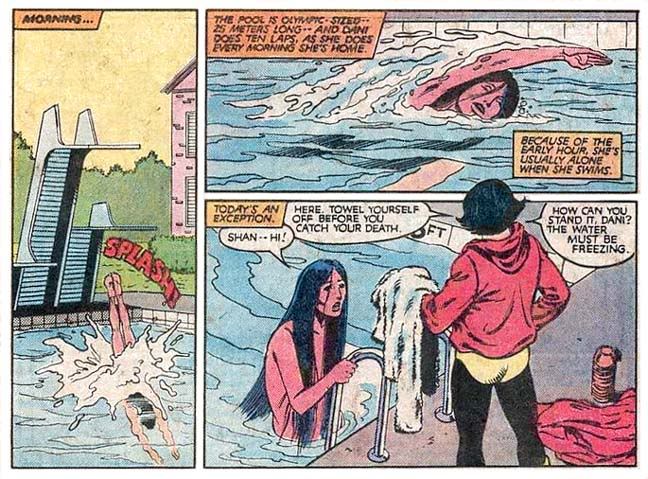 But swimming nude isn't always appropriate. Even Dani, with her clothing-optional lifestyle, knows that! That's why she always packs an actual swimsuit or two when she and her teammates head down to the Amazonian rain forest. You always want to undress to impress because you never know who's going to be watching when you impulsively dive into the piranha-infested waters of the mighty Amazon River.
But swimming nude isn't always appropriate. Even Dani, with her clothing-optional lifestyle, knows that! That's why she always packs an actual swimsuit or two when she and her teammates head down to the Amazonian rain forest. You always want to undress to impress because you never know who's going to be watching when you impulsively dive into the piranha-infested waters of the mighty Amazon River.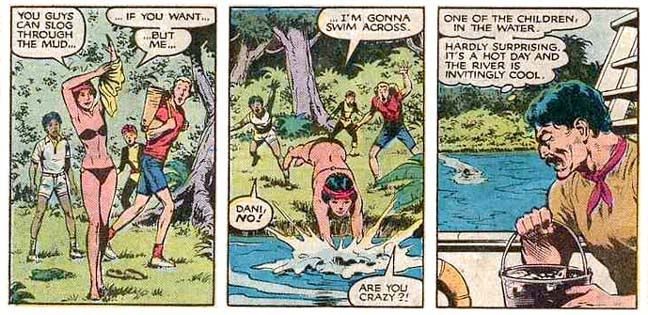 Here Dani sports a skimpy yet classy black bikini with a strapless bandeau top with a ring at center bust. As we've already seen, she's not shy. Dani believes-- and we agree-- black offers visual drama, but very little in the way of protection when a school of those carnivorous little fish makes an appearance. Whether she's cutting her way across the surface of the water with an athletic Australian crawl or fighting for her life against underwater predators, Dani is always a sensation in her black two-piece!
Here Dani sports a skimpy yet classy black bikini with a strapless bandeau top with a ring at center bust. As we've already seen, she's not shy. Dani believes-- and we agree-- black offers visual drama, but very little in the way of protection when a school of those carnivorous little fish makes an appearance. Whether she's cutting her way across the surface of the water with an athletic Australian crawl or fighting for her life against underwater predators, Dani is always a sensation in her black two-piece!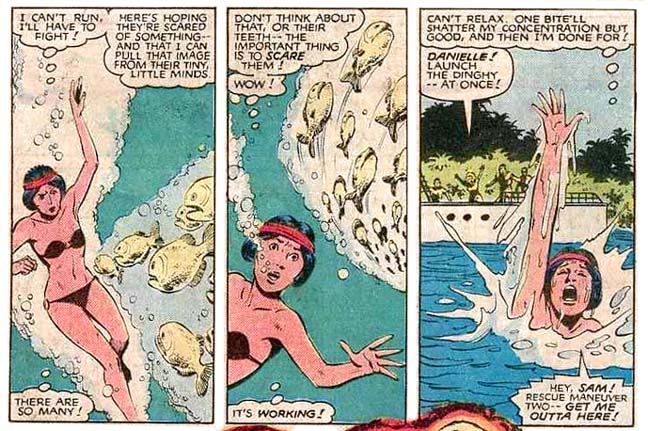 Rescue maneuver two? How often have these mutants practiced rescuing each other from fish, and just how does rescue maneuver two differ from the first one or the third one? Oh, forget all that! If rescue maneuver two consists of looking as fabulously hot as Dani while waving one arm in the face of danger, sign us up for the New Mutants water safety course!
Rescue maneuver two? How often have these mutants practiced rescuing each other from fish, and just how does rescue maneuver two differ from the first one or the third one? Oh, forget all that! If rescue maneuver two consists of looking as fabulously hot as Dani while waving one arm in the face of danger, sign us up for the New Mutants water safety course!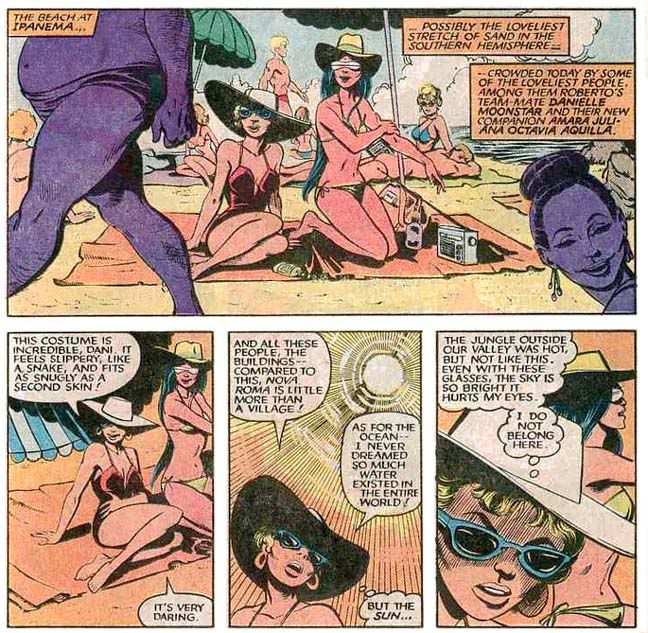 Dani loves her bandeau tops. She recommends these for anyone who shares her small-chested physique. And while it blew Dani's mind when we told her some people prefer more modest swimwear, she pulled herself together enough to suggest they try something similar to her friend Amara Juliana Octavia Aquilla's classic red maillot. The legs aren't so high-cut they're overly revealing. Amara wisely accessorizes with a wide-brimmed white hat to match Dani's jaunty yellow chapeau. Just because you're from an ancient civilization that names Apollo as one of its deities, sun-worship doesn't mean you have to court skin damage and cancers. Protect your face with a strong sun block and shading head gear, and limit your time under Apollo's rays. As you can see, the Brazilian sun is already baking poor Amara's brains!
Dani loves her bandeau tops. She recommends these for anyone who shares her small-chested physique. And while it blew Dani's mind when we told her some people prefer more modest swimwear, she pulled herself together enough to suggest they try something similar to her friend Amara Juliana Octavia Aquilla's classic red maillot. The legs aren't so high-cut they're overly revealing. Amara wisely accessorizes with a wide-brimmed white hat to match Dani's jaunty yellow chapeau. Just because you're from an ancient civilization that names Apollo as one of its deities, sun-worship doesn't mean you have to court skin damage and cancers. Protect your face with a strong sun block and shading head gear, and limit your time under Apollo's rays. As you can see, the Brazilian sun is already baking poor Amara's brains! As Roberto says, Ipanema is the place to be, so let's join the New Mutants on that fabled beach once again, where the beautiful people-- in Dani's words-- "flaunt it-- with a vengeance!" And so do our young heroes.
As Roberto says, Ipanema is the place to be, so let's join the New Mutants on that fabled beach once again, where the beautiful people-- in Dani's words-- "flaunt it-- with a vengeance!" And so do our young heroes.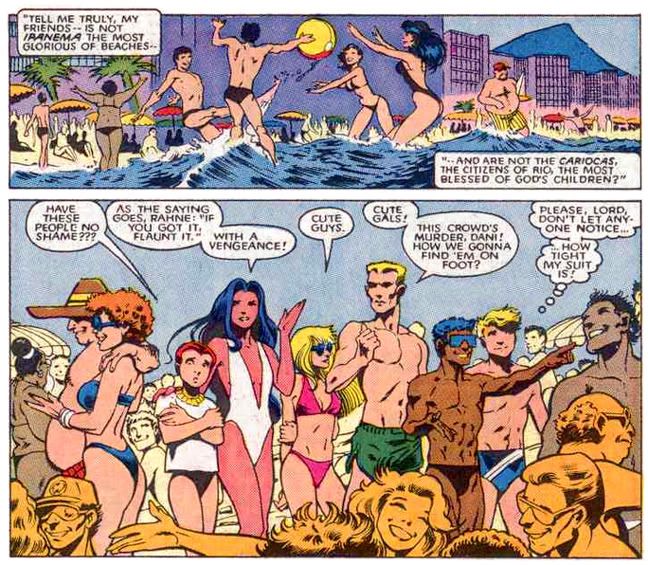 Shy Rahne Sinclair-- she of the fair Scottish complexion-- favors a sensible t-shirt cover up over what appears to be a black one-piece. In deference to her friend, Dani dials back the skin display. Just a touch; she is Dani Moonstar, after all. Here she dazzles in a white one-piece but with typical Dani derring-do. Look at that plunging neckline and those high cut sides! You may think only our Dani could get away with this, but this style is tres trendy this season, replacing the monokini we're so very over. If you've got the confidence for this brilliant backless number, Dani says, "Go for it!"
Shy Rahne Sinclair-- she of the fair Scottish complexion-- favors a sensible t-shirt cover up over what appears to be a black one-piece. In deference to her friend, Dani dials back the skin display. Just a touch; she is Dani Moonstar, after all. Here she dazzles in a white one-piece but with typical Dani derring-do. Look at that plunging neckline and those high cut sides! You may think only our Dani could get away with this, but this style is tres trendy this season, replacing the monokini we're so very over. If you've got the confidence for this brilliant backless number, Dani says, "Go for it!"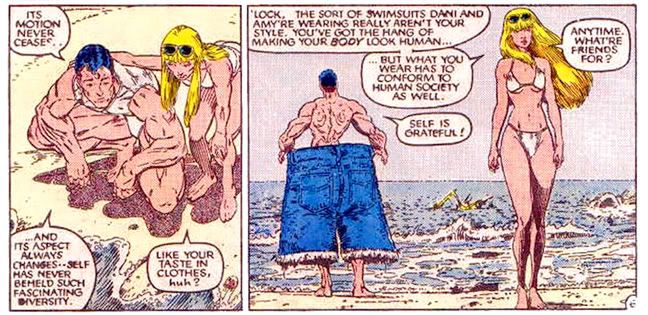 A teen dressed like a pole dancer giving someone else swimsuit advice? Ironic, huh? Illyana has quite the bangin' bod, so it would be hard for her to wrong sporting a string triangle top and bottom, and yet she does! Oh how she goes wrong! Illyana's choice of material here is unfortunate. Metallic silver is better suited for an extra dancing in the background of the Bada Bing! on TV's The Sopranos, not a semi-evil sorcerous on vacation on some sun-splashed Greek island.
A teen dressed like a pole dancer giving someone else swimsuit advice? Ironic, huh? Illyana has quite the bangin' bod, so it would be hard for her to wrong sporting a string triangle top and bottom, and yet she does! Oh how she goes wrong! Illyana's choice of material here is unfortunate. Metallic silver is better suited for an extra dancing in the background of the Bada Bing! on TV's The Sopranos, not a semi-evil sorcerous on vacation on some sun-splashed Greek island.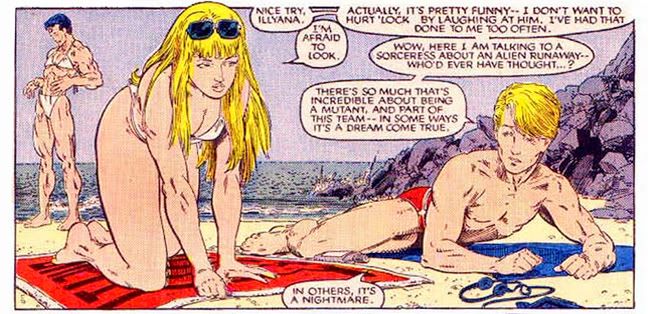 Oh, for the love of... Actually, that's an improvement. Rock on, Bikini-Boy! Speaking of improvements, here's Doug looking more relaxed in a pair of red swim briefs, even if they're smaller than his Ipanema suit. As we've learned from Dani, the best accessory for any swimsuit is self-confidence, and Doug is so full of it!
Oh, for the love of... Actually, that's an improvement. Rock on, Bikini-Boy! Speaking of improvements, here's Doug looking more relaxed in a pair of red swim briefs, even if they're smaller than his Ipanema suit. As we've learned from Dani, the best accessory for any swimsuit is self-confidence, and Doug is so full of it!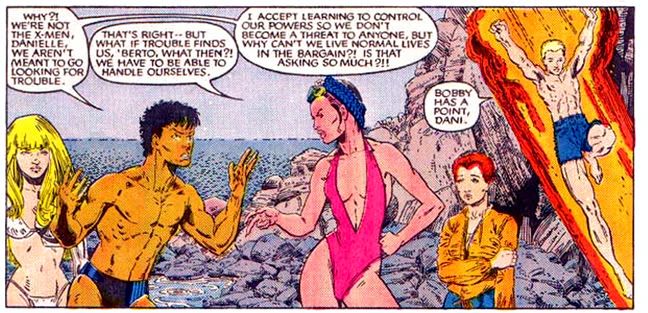 Here she is in another one-piece with an extreme neckline, this time in marvelous magenta. Dani is indeed our go-to girl for amazingly sexy swimwear looks! Rahne has covered herself again, donning an orange windbreaker over an athletic black singlet. Sam shows off his Kentucky upbringing in a pair of cut-off jeans more suited for the ol' swimmin' hole or the creek-- provided the his former coal company employers haven't blown both to hell and back looking for the black rock-- than the Mediterranean. Cautionary tale number 4!
Here she is in another one-piece with an extreme neckline, this time in marvelous magenta. Dani is indeed our go-to girl for amazingly sexy swimwear looks! Rahne has covered herself again, donning an orange windbreaker over an athletic black singlet. Sam shows off his Kentucky upbringing in a pair of cut-off jeans more suited for the ol' swimmin' hole or the creek-- provided the his former coal company employers haven't blown both to hell and back looking for the black rock-- than the Mediterranean. Cautionary tale number 4!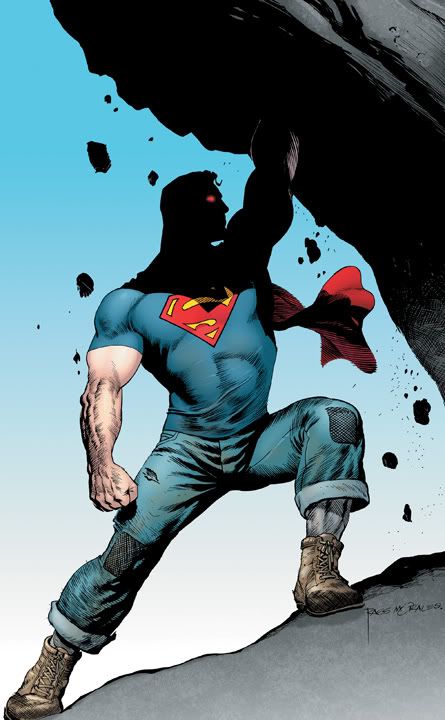 Morales will be illustrating Grant Morrison's scripts for the new Action Comics #1. DC's The Source blog says, "Superman defends a world that doesn’t trust their first Super Hero."
Morales will be illustrating Grant Morrison's scripts for the new Action Comics #1. DC's The Source blog says, "Superman defends a world that doesn’t trust their first Super Hero."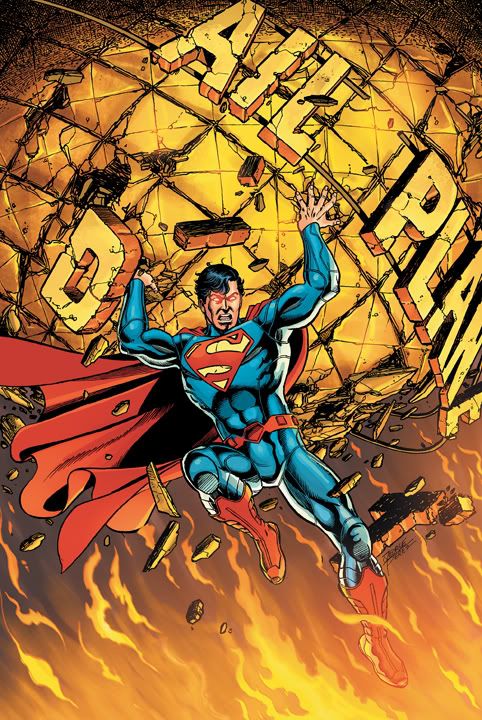 Oh. How unfortunate.
Oh. How unfortunate.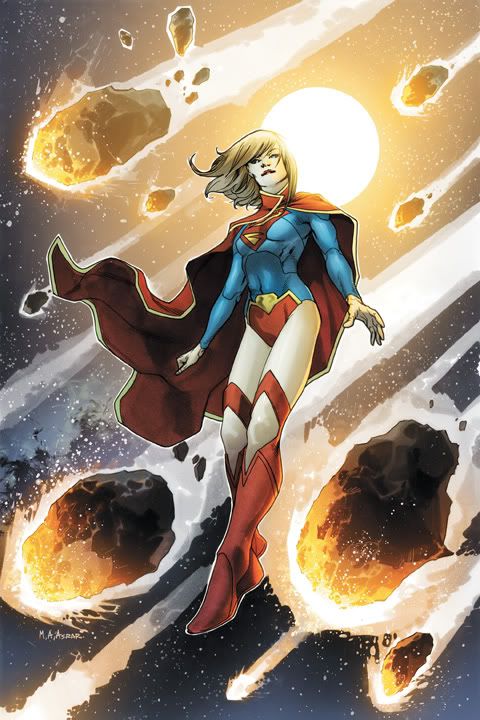 Way to go, DC! For too long the bare middrift has been the visual cliche signifying "this is a teenaged girl" character. Aybar's Supergirl drawing gives her an otherworldly, dignified appearance. What? No navel ring or lower back tattoo? The new Supergirl costume with its long sleeves, shawl/cape arrangement and stylish over-the-knee boots actually covers more girl than I'm used to in my DC comics. I can't get over a Supergirl wearing more clothing than an Olympic gymnast and not looking like Lindsay Lohan in the middle of a 2-week coke and booze binge.
Way to go, DC! For too long the bare middrift has been the visual cliche signifying "this is a teenaged girl" character. Aybar's Supergirl drawing gives her an otherworldly, dignified appearance. What? No navel ring or lower back tattoo? The new Supergirl costume with its long sleeves, shawl/cape arrangement and stylish over-the-knee boots actually covers more girl than I'm used to in my DC comics. I can't get over a Supergirl wearing more clothing than an Olympic gymnast and not looking like Lindsay Lohan in the middle of a 2-week coke and booze binge.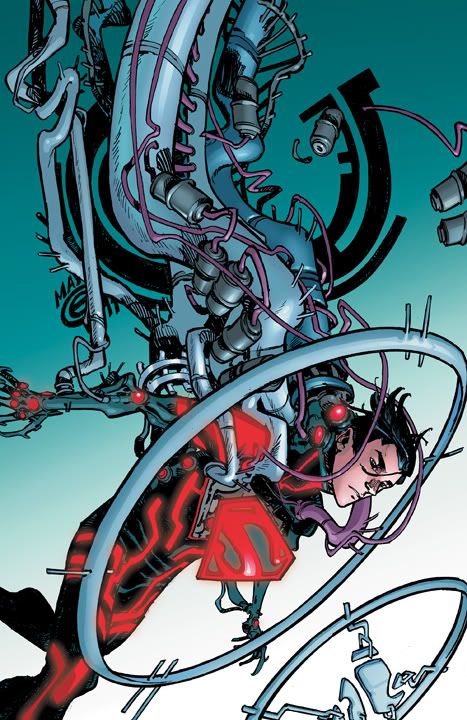 This is the first image from one of DC's more surprising experiments-- Superboy in the Shell: Fly Alone Complex by Japanese comics master Masamune Shirow. In this wild departure, Superboy is actually a bit of sentient code inside a computer matrix in some far-flung cyber-future where the traditional DC superheroes may or may not have existed. And there's nudity, lots and lots of it. Plus violence as Superboy passes between his virtual world and what may or may not be the real one to battle international terrorists and code-hackers. Shirow explores themes of technology gone amok and transhumanism, as well as more personal issues such as sexuality, identity, friendship, trust and what's for lunch.
This is the first image from one of DC's more surprising experiments-- Superboy in the Shell: Fly Alone Complex by Japanese comics master Masamune Shirow. In this wild departure, Superboy is actually a bit of sentient code inside a computer matrix in some far-flung cyber-future where the traditional DC superheroes may or may not have existed. And there's nudity, lots and lots of it. Plus violence as Superboy passes between his virtual world and what may or may not be the real one to battle international terrorists and code-hackers. Shirow explores themes of technology gone amok and transhumanism, as well as more personal issues such as sexuality, identity, friendship, trust and what's for lunch.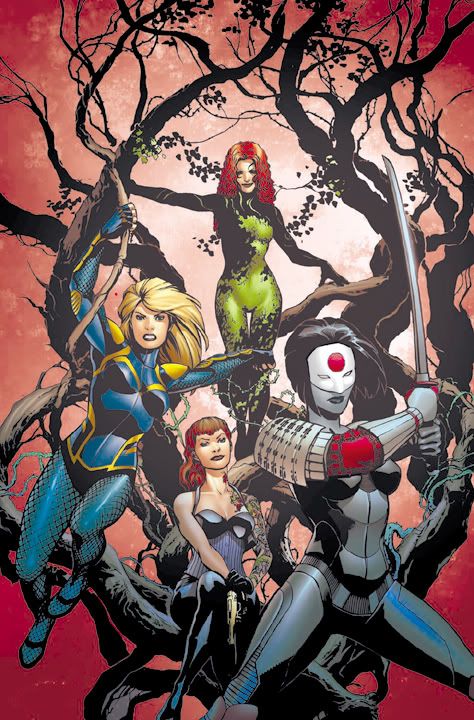 Let's talk about something positive. Let's talk about the inspired new costume Katana will sport in the upcoming Birds of Prey series by Duane Swierczynski and Jesus Saiz. I love the old Batman and the Outsiders series, so I have a soft spot for Katana. Besides Batman himself (old school Batman, not 1990s-2000s Batman), she's always been my favorite Outsiders team member. I haven't kept up with all the developments in her ongoing narrative, but now I see she's got a sharp new outfit. It sleek yet powerful, and announces Katana as a force to be reckoned with. I hope the writing measures up to the visual.
Let's talk about something positive. Let's talk about the inspired new costume Katana will sport in the upcoming Birds of Prey series by Duane Swierczynski and Jesus Saiz. I love the old Batman and the Outsiders series, so I have a soft spot for Katana. Besides Batman himself (old school Batman, not 1990s-2000s Batman), she's always been my favorite Outsiders team member. I haven't kept up with all the developments in her ongoing narrative, but now I see she's got a sharp new outfit. It sleek yet powerful, and announces Katana as a force to be reckoned with. I hope the writing measures up to the visual.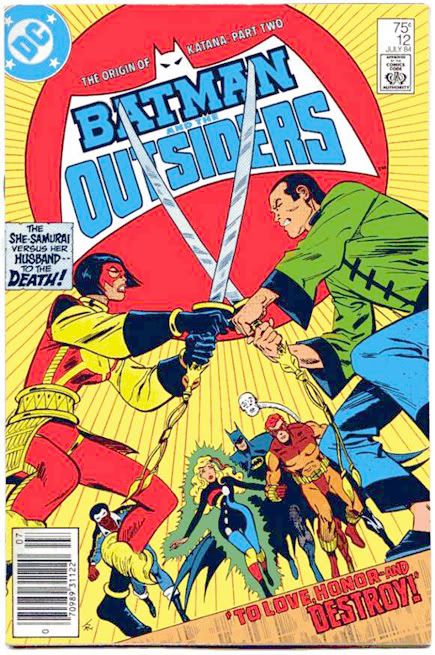 While I lived in Japan for 6 years, I didn't meet too many samurai or ninja. Yeah, I hate to disappoint you, but there aren't a whole lot of ancient families living the bushido code in the high-tech urban landscapes of Tokyo and Osaka, no rooftop battles at night between American costumed heroes and hundreds of black-clad assassins. No haughty businessmen who spend their off hours railing at their kids for not upholding the family's honor who are also secretly training sword-wielding armies to protect their virginal daughters against the handsome yet deadly oldest son of their hereditary enemy clan. I'm not sure if they all live in a certain prefecture and I just didn't get up that way, or if they were all around me and their ancient martial arts powers of invisibility hid them from my idiot eyes. But I did see a few suits of samurai armor in museums. None of them were 100% magenta+100% yellow/100% yellow. Maybe those are too valuable to display. Or maybe I needed to order a tsukimi baga to catch even a glimpse.
While I lived in Japan for 6 years, I didn't meet too many samurai or ninja. Yeah, I hate to disappoint you, but there aren't a whole lot of ancient families living the bushido code in the high-tech urban landscapes of Tokyo and Osaka, no rooftop battles at night between American costumed heroes and hundreds of black-clad assassins. No haughty businessmen who spend their off hours railing at their kids for not upholding the family's honor who are also secretly training sword-wielding armies to protect their virginal daughters against the handsome yet deadly oldest son of their hereditary enemy clan. I'm not sure if they all live in a certain prefecture and I just didn't get up that way, or if they were all around me and their ancient martial arts powers of invisibility hid them from my idiot eyes. But I did see a few suits of samurai armor in museums. None of them were 100% magenta+100% yellow/100% yellow. Maybe those are too valuable to display. Or maybe I needed to order a tsukimi baga to catch even a glimpse.